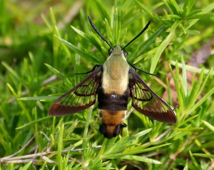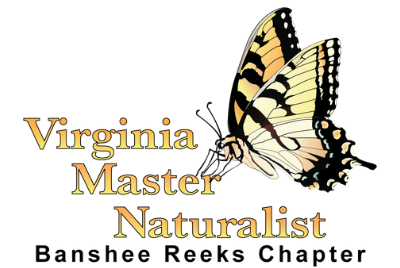Hummingbird Moth


One of the most delightful insect visitors to our
garden is the hummingbird moth. Several species
of the genus Hemaris deserve this name and for
very good reason. They fly and move just like
hummingbirds and are sometimes small enough
to look like large bumblebees. They can remain
suspended in the air in front of a flower while
they unfurl their long tongues and insert them in
flowers to sip their nectar. They even emit an
audible hum like hummingbirds. And just for our
enjoyment, unlike most moths, they fly around in
the middle of the day.
Hummingbird moths are rather plump; the tip of
their tail opens into a fan. They are usually of a
rich reddish brown color, at least in part. Like all
Lepidoptera their wings are covered by scales; some
species lose many of the scales on their wings, so
they are called clearwing hummingbird moths. Like
most moths, they have a very long tongue which
they carry rolled under their chins and that they use
to reach the nectar of long-necked flowers. These
day-flying moths are widespread in North
America. There are four species of hummingbird
moths in North America. The most familiar ones that
I have seen are the Snowberry Clearwing (Hemaris
diffinis) and the Hummingbird Clearwing (Hemaris
thysbe). As a novice Hemaris sp. observer, the only
way I can distinguish the difference is the
Hummingbird Clearwing Hemaris Thysbe, has whitish
legs and a wingspan of 40-55mm while the
Snowberry Clearwing Hemaris diffinis, has black legs
and slightly smaller wingspan of 35-50mm.
Like the majority of moths and butterflies, the adult
hummingbird moths feed on nectar from a variety of
flowers, but their larvae need more specific food
plants, such as several species of honeysuckle,
dogbane, or some members of the rose family such
as hawthorn, cherries, and plums.
The adults may start flying in early spring, when the
bluebells (Mertensia) are still blooming, but you will
have a better chance to see them when they are
most active, in the summer, when the bee balms are
in bloom. If you have phlox (Phlox), beebalm
(Monarda), honeysuckle (Lonicera), or verbena
(Verbena) you are also likely to see these wonderful
insects visiting these flowers.
The females entice the males with an aroma or
pheromone that they produce from glands at the tip
of the abdomen. After mating, they lay their tiny,
round, green eggs on their larval food plants, usually
on the underside of the leaves. The caterpillars have
a horn at the rear end and are commonly green, well
camouflaged among the leaves. When they are fully-
grown they drop to the ground, spin a loose cocoon
and pupate, partially protected by leaf litter. That
leaf litter provides a shelter to this beautiful
pollinator. In the north, where the season is short
there is only one generation per year; the pupa
spends the whole winter well-hidden and the adult
does not emerge until the next spring. In the
south, there is usually more than one generation
each summer. Although they only live several
months, during the summer, they are beautiful
and fascinating creatures, whose quick speed
and short flower visit time make them hard to
spot but definitely worth looking for.
For further information check out;
For further information check out;
www.butterfliesandmoths butterfliesandmoths butterfliesandmoths.org
Snowberry Clearwing Hemaris diffinis
